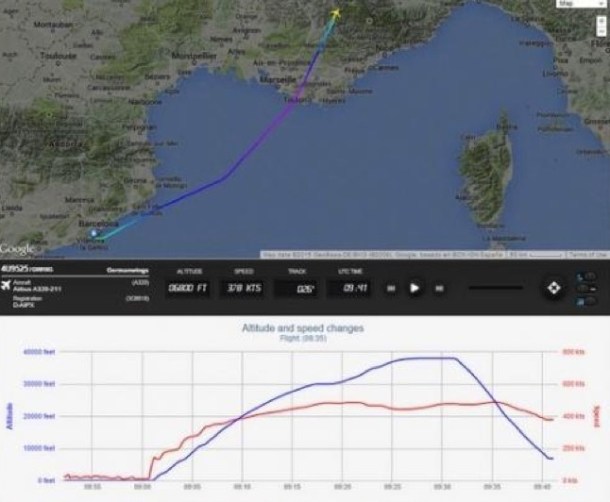Darkness has fallen over the site of yesterday’s Germanwings disaster in France, and there are, as would be expected at this stage, no early answers as to its cause.
A flight data recorder has already been picked up from the crash zone, which begins at 2000 metres well below the current snow line. All 150 people onboard, including two Australians from Victoria, were killed.
The A320 crashed into a steep hillside scattering wreckage in very small pieces across terrain which is grooved with rocky open gulches and above the treeline. However that steepness will challenge recovery teams when daylight returns much later today.
The graphical depiction of the flight path broadcast on the internet by Flightradar 24 (below) shows how the A320 began descending rapidly very shortly after it reached its cruise altitude of 38,000 feet and after eight minutes passed through 11,000 feet.

In his technical report Simon Hradecky at Aviation Herald says the jet then dropped to 6800 feet and flew level briefly at that height before disappearing off ATC radar.
The terrain immediately ahead of the jet rose to 8900 feet. According to initial search helicopter reports yesterday, the first wreckage sighted was as high as 8800 feet indicating the force of the impact lower down and across the face of the mountain which occurred about nine minutes after the Germanwings flight left its assigned cruise altitude.
There was no communication from the A320 during those nine minutes. The Flight radar data show that it flew on an essentially constant heading without deviating left or right until impact, although there was some reduction in its speed which nevertheless remained high.
One of the many unanswered questions is why the flight didn’t change its heading to fly away from the high terrain of the Provence Alps during the descent. Had this been a cabin depressurisation emergency the expectation would be that the pilots would be aware of, and determined to avoid, the mountains, with clear space for such a course immediately to the left of the descent trajectory.
However such speculation is made in what remains a factual vacuum.
It is clear that all of the wreckage and hopefully both flight data recorders and possibly the less robust and less detailed third data device, the quick access data recorder, will be found and read.
If readable, the cockpit sound recorder should indicate what crisis overtook the Germanwings flight so abruptly that its pilots had no time to make an emergency call as they attempted to manage the event that suddenly confronted them.








Crikey is committed to hosting lively discussions. Help us keep the conversation useful, interesting and welcoming. We aim to publish comments quickly in the interest of promoting robust conversation, but we’re a small team and we deploy filters to protect against legal risk. Occasionally your comment may be held up while we review, but we’re working as fast as we can to keep the conversation rolling.
The Crikey comment section is members-only content. Please subscribe to leave a comment.
The Crikey comment section is members-only content. Please login to leave a comment.